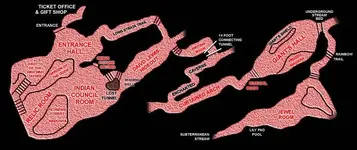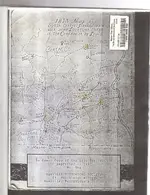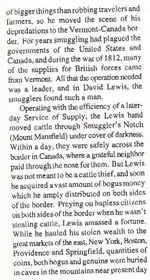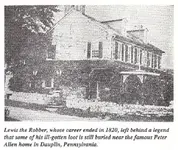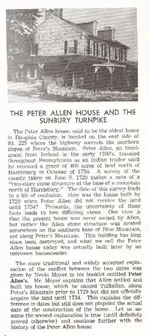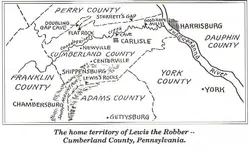HISTORY OF DAVID LEWIS
In the early Nineteenth Century, Indian Caverns was one of the many hiding places of the band of highwaymen associated with David Lewis—popularly known as "Robber" or "Davie" Lewis. A history of the various incidents in the life of this "Robin Hood of Pennsylvania" would be as strange and as fascinating a story as any work of fiction.
Born in 1790, Lewis moved with his family to Bellefonte, Pennsylvania, when he was ten years old. Robber Lewis reportedly made his early fortune by counterfeiting bank notes and through acts of highway robbery as far afield as New England. By his early twenties, Lewis focussed on operating more locally. His activities as an "equalizer", as he called himself, covered the mountain system of Pennsylvania from Lock Haven to Bedford. There are many local tales of Robber Lewis' exploits, robbing from wealthy landowners and merchants and assisting poor farmers and laborers facing hard times, foreclosure, or bankruptcy.
The following is an extract from an article in the Topographic and Geologic Survey Bulletin on Franklin Township by Ralph W. Stone from 1921, the only account of David Lewis to have appreared in print this century:
In the early period of the manufacture of charcoal-iron, Franklin Township was the site of six or eight forges and a woolen mill. Franklinville was at that time one of the busiest places in [Huntingdon] county.
Among the pioneer iron manufacturers at the head of this once flourishing industry we find the name of David Rittenhouse Porter, whose subsequent career as a public man and later Governor of the State is a matter of general history.
Another prominent iron manufacturer was Dr. Peter Shoenberger, whose forges were the beginning of his enormous wealth. His early struggles and noted encounter with the robber David Lewis, are valley history. The meeting with Lewis took place one early morning as Dr. Shoenberger was en route to Bellefonte with $15,000 cash in his saddle-bags. Unless he reached Bellefonte by a certain time, his paper must go to protest and his credit be ruined.
After the doctor had passed by a cave above the Franklinville Woolen Mill, he was suddenly confronted by a large man on horseback, who, with pistol in hand, called on him to "stand and deliver". Facing financial ruin, the doctor started to unstrap his saddle-bags. Suddenly he heard a shout and saw the white covers of a Conestoga wagon topping the hill. In desperation the doctor yelled out "Men, I am being robbed! Help! Help!" Lewis pulled the trigger of his gun, but, fortunately, the old flint only snapped and under fire from the wagoners Lewis rode into the woods and escaped.
From 1816 to 1820, Lewis and his band of robbers used this cave as a retreat and perhaps as a storehouse for their plunder. In a deathbed confession, Lewis is reported to have hidden a forune of gold near the old woolen mill, which the cave overlooked. Long stretches of the cave have been explored, and the remains of ladders that had been nailed together with hand-made nails were found at places of difficult ascent. These had probably been built by a former occupant or treasure hunter.
The cave entrance
as it would have appeared ca.1816
In 1820, a Centre County posse captured Lewis for holding up a Bellefonte-bound wagon train on the Seven Mountains road. During the gun battle, Lewis was wounded and, shortly after his capture, he contracted pneumonia and died.
On his deathbed in Bellefonte Jail, he claimed that he had secreted away some $20,000, mostly in gold, where even his confederates could not find it. Not long before his death, he had written to a friend residing on a farm in the Spruce Creek Valley telling him that his loot was hidden in "a dank hideout room" from which he claimed he could see the workmen in the old woolen mill going about their tasks. This woolen mill stood in the center of what is now Indian Caverns' parking lot. So strongly founded was the belief in the bandit's story that numerous treasure hunters have searched in the cave for Robber Lewis' legacy.
Impelled by this same belief, one resident of Franklin Township spent over twenty years in a vain search for the treasure. Armed with a lantern and a ball of twine, used as a trail marker so that he would not become lost in the labyrinth of passages, he kept up his tireless search. Death ended his quest in the 1920s with the robber's hidden gold-bags still unfound.
Treasure-hunters believe Robber Lewis may have concealed or walled-up the entrance to one of the cave rooms opening from the Lost Tunnel in the cave so perfectly that no one has been able to discover its exact location.
David Lewis died at the age of thirty in Bellefonte Jail and, according to records in Huntingdon County Library, was buried in Milesburg, Pennsylvania. Somewhere deep within Indian Caverns, does the mystery room still guard the secret of the bandit's treasure trove?
More information on "Robber" Lewis can be found in the Virtual Tour of the cave—or, of course, by visiting the cavern itself!
http://www.indiancaverns.com/History02.html


